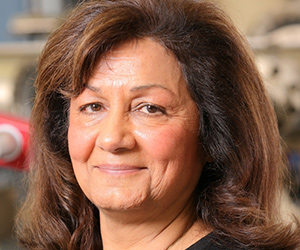Razeghi Delivered Keynote Talk at SPIE WEST 2014 Conference Wednesday 2/5
As part of the morning Keynote Session, Prof. Razeghi's talk was titled, "III-V semiconductor optoelectronic devices from UV to THz: recent advances and future trends," (please see abstract below).
 Manijeh Razeghi, Walter P. Murphy Professor; Director of Center for Quantum Devices presented a keynote talk at SPIE WEST 2014 Conference on Wednesday February 5, 2014 at the Moscone Center in San Francisco, California.
Manijeh Razeghi, Walter P. Murphy Professor; Director of Center for Quantum Devices presented a keynote talk at SPIE WEST 2014 Conference on Wednesday February 5, 2014 at the Moscone Center in San Francisco, California.
As part of the morning Keynote Session, Prof. Razeghi's talk was titled,"III-V semiconductor optoelectronic devices from UV to THz: recent advances and future trends," (please see abstract below).
Abstract: Nature offers us different kinds of atoms, but it takes human intelligence to put them together in an elegant way in order to realize functional structures not found in nature. The so-called III-V semiconductors are made of atoms from columns III ( B, Al, Ga, In. Tl) and columns V( N, As, P, Sb,Bi) of the periodic table, and constitute a particularly rich variety of compounds with many useful optical and electronic properties. Guided by highly accurate simulations of the electronic structure, modern semiconductor optoelectronic devices are literally made atom by atom using advanced growth technology such as Molecular Beam Epitaxy (MBE) and Metal Organic Chemical Vapor Deposition (MOCVD). Recent breakthroughs have brought quantum engineering to an unprecedented level, creating light detectors and emitters over an extremely wide spectral range from 0.2 um to 300 um. Nitrogen serves as the best column V element for the short wavelength side of the electromagnetic spectrum, where we have demonstrated III-nitride light emitting diodes and photo detectors in the deep ultraviolet to visible wavelengths. In the infrared, III-V compounds using phosphorus ,arsenic and antimony from column V ,and indium, gallium, aluminum, ,and thallium from column III elements can create interband and intrsuband lasers and detectors based on quantum-dot (QD) or type-II superlattice (T2SL). These are fast becoming the choice of technology in crucial applications such as environmental monitoring and space exploration. Last but not the least, on the far-infrared end of the electromagnetic spectrum, also known as the terahertz (THz) region, III-V semiconductors offer a unique solution of generating THz waves in a compact device at room temperature. Continued effort is being devoted to all of the above mentioned areas with the intention to develop smart technologies that meet the current challenges in environment, health, security, and energy. This talk will highlight my contributions to the world of III-V semiconductor Nano scale optoelectronics, devices from deep-UV to THz.
SPIE Photonics West 2014 is the largest and most influential event for the laser and photonics community in North America: 20,000 attendees, two exhibitions, 1,250 exhibiting companies, a wide range of papers on biomedical optics, biophotonics, translational research, industrial lasers, optoelectronics, microfabrication, optical MEMS, and more.
